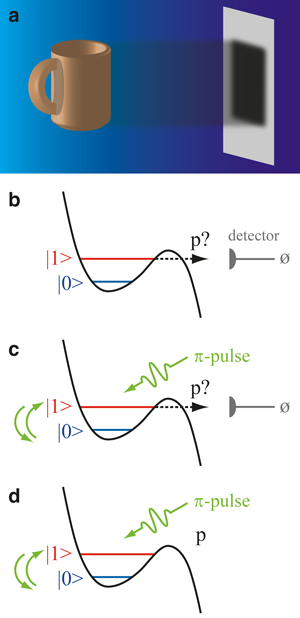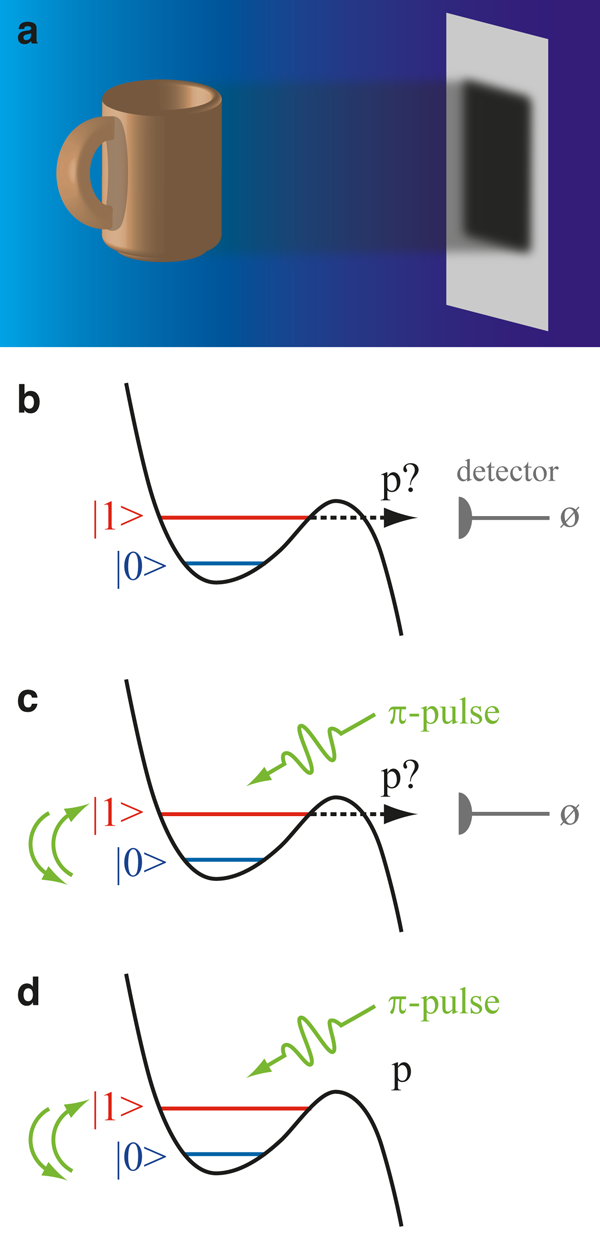Undoing a quantum measurement
In quantum mechanics courses, students learn that the possible results of a quantum measurement of a physical quantity are the eigenvalues of the operator corresponding to the physical quantity. In other words, a measurement of the physical system “projects” it onto one of the eigenstates of this operator. In general, this only can happen in one direction: mathematically, the projection cannot be inverted, so it is an irreversible process. However, there are more gentle measurement schemes that only acquire partial information and so escape the constraint of traveling down this one-way street. A recent experiment on superconducting phase qubits performed by Nadav Katz and colleagues at University of California, Santa Barbara, and the University of California, Riverside [1], demonstrates that the effect of such a measurement can be “undone” and the initial state can be recovered.
Immediately after a measurement, the physical system will be in an eigenstate belonging to the eigenvalue , which is the measured value of the observable property. Since the transition from the state before the measurement to the state after the measurement is, mathematically speaking, a projection, there is in general no way of reconstructing if you know (think of the shadow of a three-dimensional object on a screen, as in Fig. 1(a)—by just knowing a shadow, you cannot reconstruct the object). However, this type of measurement (a so-called strong or von Neumann measurement) is an idealized and extreme form of quantum measurement.
It has long been understood that not every quantum measurement can be described by von Neumann’s paradigm, which has come to be called the “collapse of the wave function” from to . For instance, if you measure a current in a mesoscopic device, there is no single projection or collapse event, but many electrons passing a wire will successively build up the information that can be read out by an ammeter. Recently, however, there has been much interest in a different kind of quantum measurement called “weak” measurement. The idea of weak (continuous) measurements was developed in quantum optics [2]. Although these measurements yield only limited information about the system, they allow a continuous observation that will perturb the system only weakly. The transition from the initial state of the system to the final state after the measurement due to the acquisition of information during the measurement does not correspond to a projection. As a result, the measurement can be inverted, and the initial state of the system can be recovered.
In the experiment carried out by Katz et al. [1], which is based on earlier theoretical work [3], this state recovery has been demonstrated for the first time. The system under consideration is a superconducting phase qubit—i.e., a superconducting loop containing a Josephson junction that can be considered as an effective two-level system [see Fig. 1(b)]. The qubit can be measured by a special type of detector that has the following properties: (i) if the qubit is in its upper (excited) state , the detector will click with probability during the measurement interval, and (ii) it will never click if the qubit is in its lower (ground) state .
If the detector does not click, we cannot be sure that the qubit is in its ground state. However, clearly we have acquired partial information (chances are higher than before the measurement that the qubit is in its ground state), and this information leads to a change of the state of the qubit compared to its initial state, namely a “partial collapse” towards .
This partial collapse can now be undone in the following way [3]: After the first null-result measurement, swap the amplitudes of the states and by a special kind of stimulus called a -pulse [Fig. 1(c)]. (The -pulse or 180° pulse was originally devised to swap the high- and low-energy spin populations in NMR experiments.) Then apply a second measurement of the same type as the first one. If there is no detector click during the second measurement as well, i.e., if it happens to be again a null-result measurement, another -pulse will restore the qubit to the initial state it was in before both measurements [Fig. 1(d)]. Note the “if” in the last phrase: the procedure may not work—there may be a click during the second measurement. However, in the absence of a click during both measurements (which can be shown to happen with probability ), we are guaranteed to get back the initial state.
One may wonder how all of this is compatible with the limiting case of a strong (von Neumann) measurement. A strong measurement corresponds to the limit : in this case, the probability of getting two consecutive null measurements (which is necessary for the reversal of the partial collapse) goes to zero. Hence the “uncollapsing” procedure will not be possible, which is consistent with the irreversibility of the strong measurement.
How did the authors implement the detector described above? The phase qubit can be thought of as a particle in the minimum of a cubic potential which has two (quasi-) bound states [see Fig. 1(b)]. The measurement corresponds to lowering the barrier height (by changing the Josephson junction bias current) for a well-defined time such that the particle will escape the well with probability if it is in the upper state. The escape probability for a particle in the lower state is negligibly small. The energy relaxation time and the dephasing time are significantly longer than the duration of the experiment, so relaxation and dephasing processes can be neglected.
To prove that this measurement scheme leads to a partial collapse of the initial state, Katz et al. used quantum tomography [4]. This is a procedure in which measurements are made on an ensemble of identical systems in order to collect a full picture of the state of the system, much like x-ray tomography where images from many angles are combined to create a 3D image. Similarly, at the end of the recovery procedure, quantum tomography was employed to check the fidelity of the whole process: the recovery procedure was repeated many times, and the , , and components of the “spin” of the qubit were measured to check whether the final state is equal or close to the initial state.
For probabilities , the reversal fidelity, i.e., the overlap of the recovered state with the initial state, was found to be higher than 70%. The protocol begins to fail at larger , since energy relaxation processes to the ground state cannot be neglected any more. This surprising state recovery is (yet) another example that research on quantum computing and on experimental realizations of quantum bits leads to a better understanding of the foundations and the interpretation of quantum mechanics.
References
- N. Katz, M. Neeley, M. Ansmann, R. C. Bialczak, M. Hofheinz, E. Lucero, A. O’Connell, H. Wang, A. N. Cleland, J. M. Martinis, and A. N. Korotkov, Phys. Rev. Lett. 101, 200401 (2008)
- V.B. Braginsky and F.Y. Khalili, Quantum measurement [Amazon][WorldCat] (Cambridge University Press, Cambridge,1992)
- A.N. Korotkov and A.N. Jordan, Phys. Rev. Lett. 97, 166805 (2006)
- N. Katz et al., Science 312, 1498 (2006)





